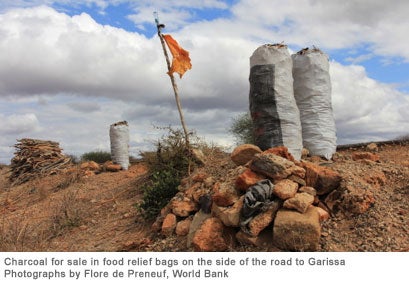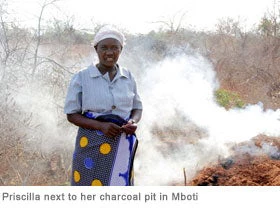
Many on this blog have written about the triple win of improved livelihoods, increased climate resilience and carbon capture. That vision of climate-smart agriculture and sustainable forest management is one of hope and necessity against a backdrop of food price volatility and climate extremes. Last week I was able to spend time studying the said “backdrop” – in the Eastern province of Kenya, where farmers who have last seen rain in March 2010 are cutting down trees to survive.
I spoke to farmers in Mboti, a community of about 100 families scattered in a world of thorny white bushes, red earth and isolated trees. Even in good times, they are brave people living on rain-fed agriculture in a region that gets much less average precipitation than Kenya's lush and populous highlands. They live on the edge – coexisting and sometimes competing with nomadic herders for salty water drawn from boreholes, one jerrycan at a time.
But the farmers' endurance has been stretched to the limit. The heavy rains of November didn't materialize (it drizzled) and the April showers never did either. Priscilla Mwangangi, a 60 year-old widow, plowed her fields this spring hoping she could sow millet and sorghum, but instead spends her time minding a mound of charcoal which she feeds by chopping down acacia trees around her property. One big bag of charcoal sells for 400 Kenyan shillings – about $5.

It's not clear how long the land can be stripped of its vegetation before irreversible damage is done. No one is planting trees in this area to replace the ones that are chopped, charred or stripped by goats – or making sure they have time to regenerate. Exposed and eroded river banks translate into flash floods (when it rains) that leave little water behind to grow crops, grass and trees. Water runs off in gullies. Top soil is washed away, silting the dams on the Tana river that Kenya depends on for power. Farmers believe the gradual loss of forest cover in the last decades is somehow responsible for uneven rainfall. Whether it's true or not at the micro-climate level, the links between extreme weather, poverty and land degradation are all too obvious. Contrite but desperate, farmers are forced to attend to urgent matters, feeding the charcoal pit like a crying baby, turning trees into food as fast as they can.


Join the Conversation